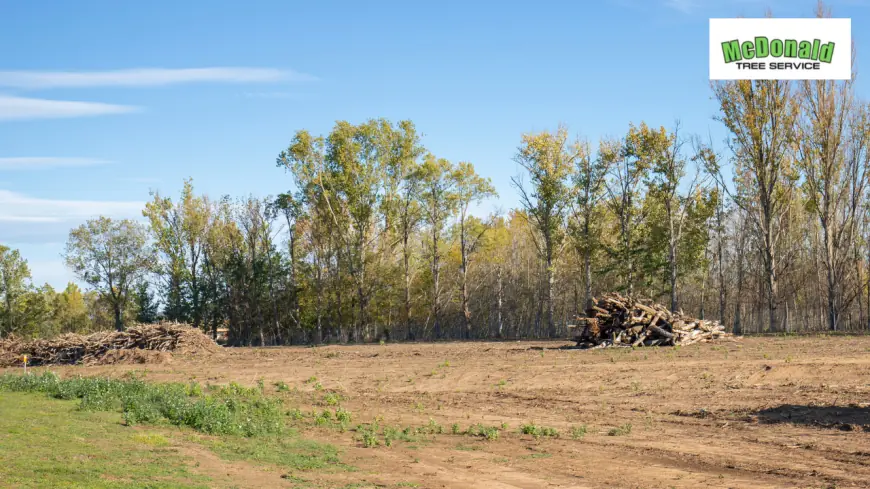How to Prepare Your Property Before Lot Clearing Services Arrive
Prepare your property for lot clearing services with this complete guide. Tips for residential & commercial projects from MacDonald Tree experts.

When you've made the decision to transform your property through professional lot clearing services, proper preparation becomes the foundation of a successful project. Whether you're planning residential lot clearing for a new home construction or commercial lot clearing for business expansion, taking the right steps beforehand can save you time, money, and prevent potential complications.
The difference between a smooth lot clearing operation and one filled with delays often comes down to how well you prepare your property. Professional teams like MacDonald Tree have seen countless projects where proper preparation made all the difference in achieving optimal results while staying on schedule and within budget.
Understanding What Proper Preparation Accomplishes
Before diving into the preparation checklist, it's important to understand why this process matters so much. Proper preparation for lot clearing services offers several key benefits that directly impact your project's success.
First, preparation significantly improves safety for everyone involved. When potential hazards are identified and addressed beforehand, the lot clearing team can work more efficiently without unexpected interruptions. This includes everything from marking underground utilities to removing obstacles that could interfere with heavy equipment operation.
Second, thorough preparation often reduces overall project costs. When lot clearing services can work without delays, equipment downtime decreases, and labor efficiency increases. Additionally, protecting valuable items and structures during the preparation phase prevents costly damage that might otherwise occur during the clearing process.
Finally, preparation ensures that your specific needs and preferences are clearly communicated and addressed. Whether you're clearing land for construction or need to preserve certain trees and features, advance planning makes sure nothing important gets overlooked during the actual clearing work.
Initial Property Assessment and Documentation
The first step in preparing for lot clearing services involves thoroughly documenting your property's current condition. This documentation serves multiple purposes and becomes invaluable throughout the entire process.
Start by taking comprehensive photographs and videos of your property from multiple angles. Walk the entire area that will be cleared, capturing images of existing structures, vegetation, and any unique features. Pay special attention to areas where you want to preserve specific trees or landscaping elements. These visual records help both you and the lot clearing team understand the scope of work and can be referenced if questions arise during the project.
Create a simple sketch or map of your property, marking important features like buildings, fences, valuable trees, and areas of concern. You don't need professional surveying skills for this – a basic drawing that shows relative positions and distances will suffice. This map becomes a communication tool that helps ensure everyone involved understands the project scope.
During this assessment phase, identify items of particular value or concern. Mark trees or plants you want to preserve with bright flagging tape or spray paint. Note any historical features, decorative elements, or sentimental items that need special attention. Also identify potential hazards such as old wells, septic systems, abandoned structures, or areas where you suspect buried utilities might be located.
This initial assessment phase is also the perfect time to evaluate access routes for heavy equipment. Residential lot clearing and commercial lot clearing often require different types of equipment, and understanding access limitations early helps prevent complications later.
Legal and Administrative Preparation

Before any lot clearing services begin, ensuring all legal and administrative requirements are met prevents costly delays and potential legal issues down the road.
Research local permit requirements thoroughly, as regulations vary significantly by location and project scope. Many municipalities require permits for clearing land for construction, especially when the work involves removing large trees or altering drainage patterns. Contact your local building department or planning office to understand what permits might be necessary for your specific project.
If you live in a community with a homeowner's association, check for any restrictions or approval requirements related to lot clearing. Many HOAs have guidelines about tree removal, property alterations, and construction activities that must be followed before work begins.
Property boundaries represent another critical legal consideration. Ensure you know exactly where your property lines are located and mark them clearly before lot clearing services arrive. If there's any uncertainty about boundary locations, consider hiring a surveyor to establish definitive markers. Accidentally clearing vegetation on a neighbor's property can lead to expensive legal complications and damaged relationships.
Review your homeowner's insurance policy to understand coverage related to land clearing activities. While professional lot clearing services carry their own insurance, understanding your coverage provides additional peace of mind. Verify that the lot clearing company you choose maintains adequate insurance coverage and ask to see proof of insurance before work begins.
Keep all contracts, permits, and important documentation easily accessible throughout the project. Create a project folder with copies of everything related to the lot clearing work, including contracts, permits, insurance certificates, and communication records.
Utility and Infrastructure Preparation
One of the most critical aspects of preparing for lot clearing services involves identifying and protecting all utilities and infrastructure on your property. This step cannot be overlooked, as damaging underground utilities can be dangerous and extremely expensive.
Contact 811 (Dig Safe) at least 48-72 hours before lot clearing services are scheduled to begin. This free service will send representatives from various utility companies to mark the locations of underground lines including gas, electric, water, sewer, cable, and internet connections. The markings typically last for about 30 days, so time your call appropriately.
In addition to having utilities professionally marked, gather any utility maps or documentation you might have about your property's infrastructure. Previous construction records, as-built drawings, or utility installation documentation can provide valuable supplementary information to the lot clearing team.
Above-ground infrastructure also requires careful attention during preparation. Identify all power lines, phone lines, and cable connections that might interfere with lot clearing equipment. If you have temporary electrical connections for outdoor equipment or lighting, disconnect these safely before the clearing work begins. Remove or protect outdoor lighting fixtures, security cameras, and other mounted equipment that could be damaged during the clearing process.
Water and irrigation systems need special consideration, particularly for residential lot clearing projects where existing landscaping might be partially preserved. Shut off and drain irrigation systems that serve areas being cleared. Mark sprinkler heads and underground irrigation lines clearly, and provide the lot clearing team with any documentation about your irrigation system layout. Remove portable water features, disconnect hoses, and protect spigots and outdoor plumbing fixtures.
Physical Property Preparation
The physical preparation of your property involves removing or protecting items that could interfere with lot clearing services or be damaged during the process.
Remove all personal items from the areas being cleared. This includes outdoor furniture, decorations, grills, lawn equipment, and recreational items. Don't forget about items that might be partially hidden by vegetation, such as garden tools, hoses, or children's toys that have accumulated over time.
Pay special attention to children's play equipment, which can be easily overlooked but represents both a safety hazard and potential damage risk. Swing sets, playhouses, trampolines, and other recreational equipment should be relocated well away from the clearing area.
Vehicle and equipment storage requires advance planning. Cars, trucks, trailers, boats, and recreational vehicles need to be moved to safe locations away from the work area. Remember that lot clearing equipment is large and requires significant maneuvering space, so items that seem far enough away might actually be too close.
For structures and features you want to preserve, install protective barriers as needed. This might include temporary fencing around buildings, plastic sheeting over outdoor equipment, or plywood protection for surfaces that might be damaged by flying debris. Cover or protect HVAC units, generators, pool equipment, and other valuable outdoor installations.
Create clear access routes for lot clearing equipment by removing gates, unlocking access points, and ensuring adequate space for large trucks and machinery. If your property has locked gates, provide keys or access codes to the lot clearing team. Consider the turning radius requirements for large equipment when evaluating access routes.
Communication and Coordination
Establishing clear communication with your lot clearing services provider ensures everyone understands expectations and project requirements.
Schedule a pre-service meeting with the project manager or crew leader to conduct a final walkthrough of the property. This meeting allows you to point out specific areas of concern, confirm the scope of work, and address any last-minute questions. Use this opportunity to review the project timeline and understand what to expect each day.
Exchange contact information and establish communication protocols. Get direct contact numbers for the project supervisor and understand the best times and methods for reaching them during the project. Provide your contact information and specify your availability and preferred communication methods.
Document special instructions and preferences in writing. Create a priority list that specifies which areas should be cleared first and which areas might need special attention. Note any seasonal considerations, such as nesting birds or wildlife concerns that might affect timing or methodology.
Safety and Final Preparations
Safety preparation protects everyone involved in the lot clearing process and ensures smooth project execution.
Establish safe areas for family members, pets, and vehicles during the clearing work. Plan alternative routes if the main driveway or access roads will be blocked. Prepare for noise, dust, and general disruption by planning activities away from the work area or making arrangements to stay elsewhere during the most intensive clearing periods.
Know the location of all main shut-offs for water, gas, and electricity. While professional lot clearing services take precautions to avoid utility damage, knowing how to quickly shut off services provides an additional safety measure. Keep first aid supplies readily available and maintain emergency contact numbers in an easily accessible location.
Notify neighbors about the upcoming lot clearing work, especially if the project might affect shared driveways, create noise, or block access routes. Good neighbor relations can prevent complaints and misunderstandings during the project.
What to Expect When Lot Clearing Services Arrive
Understanding what happens when the lot clearing team arrives helps you feel more confident and prepared for the process.
Professional teams typically arrive early in the morning and begin by conducting their own site assessment. Even though you've prepared thoroughly, the crew will perform their own safety check and equipment positioning evaluation. This initial survey helps them plan the most efficient approach for your specific property.
Equipment delivery and setup usually happens first, with larger machines being positioned strategically around the property. The crew will review your preparation work, check utility markings, and confirm any special instructions or areas of concern.
Throughout the project, expect regular progress updates from the crew supervisor. Professional lot clearing services maintain communication about schedule changes, unexpected discoveries, or decisions that need your input.
FAQs
Q: How far in advance should I call 811 to have utilities marked before lot clearing services begin?
A: You should call 811 at least 48-72 hours before your scheduled lot clearing services. However, it's wise to call even earlier, especially during busy seasons, as utility companies may need additional time to respond. The markings typically remain valid for about 30 days, so don't call too far in advance.
Q: Do I need permits for residential lot clearing on my own property?
A: Permit requirements vary significantly by location and project scope. Many municipalities require permits for clearing land for construction, especially when removing large trees or altering drainage patterns. Contact your local building department to determine specific requirements for your residential lot clearing project.
Q: What should I do with valuable plants or trees I want to keep during lot clearing services?
A: Mark valuable trees and plants you want to preserve with bright flagging tape or biodegradable spray paint well before the crew arrives. During your pre-service meeting with MacDonald Tree, clearly identify these items and consider having them marked on your property map. Professional lot clearing services can work around designated trees and plants when properly notified in advance.
Q: How much space do lot clearing services need for equipment access?
A: Commercial lot clearing and residential lot clearing equipment varies in size, but generally requires access routes at least 12-14 feet wide for larger machinery. The equipment also needs adequate space for maneuvering and turning, typically requiring 20-30 feet of clearance in work areas. Discuss specific access requirements with your lot clearing contractor during the planning phase.
Q: What happens if utilities are accidentally damaged during lot clearing services?
A: Professional lot clearing companies like MacDonald Tree carry insurance to cover utility damage, which is why having utilities properly marked by 811 is so important. If damage occurs despite proper precautions, the lot clearing company's insurance typically covers repair costs. However, proper preparation and communication significantly reduce the likelihood of such incidents occurring.
What's Your Reaction?
 Like
0
Like
0
 Dislike
0
Dislike
0
 Love
0
Love
0
 Funny
0
Funny
0
 Angry
0
Angry
0
 Sad
0
Sad
0
 Wow
0
Wow
0

























































